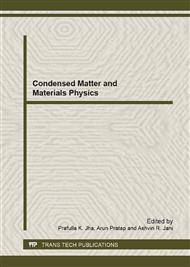[1]
Y. Chen, DD. Dionysiou, Correlation of structural properties and film thickness to photocatalytic activity of thick TiO2 films coated on stainless steel, Appl Catal B Environ 69 (2006) 24.
DOI: 10.1016/j.apcatb.2006.05.002
Google Scholar
[2]
Y. Matsumoto, M. Murakami, T. Shono, T. Hasagewa, et al., Room-temperature ferromagnetism in transparent transition metal-doped titanium dioxide, Science 291 (2001) 854–856.
DOI: 10.1126/science.1056186
Google Scholar
[3]
T. Lopez, J. Hernandez, R. Gomez, X. Bokhimi, Synthesis and Characterization of TiO2−MgO Mixed Oxides Prepared by the Sol−Gel Method, Langmuir 15 (1999) 5689.
DOI: 10.1021/la9812931
Google Scholar
[4]
W. Wang, J. Dai, J. Tang, et al., J. Superconduct. 16 (2003) 155.
Google Scholar
[5]
C.E. Rodriguez Torres, A.F. Cabrera, M.B. Fernandez van Raap, et al., Physica B 354 (2004) 67.
Google Scholar
[6]
P. Kumar, K. Nair, Porous nanocomposites as catalyst supports: Part I. second phase stabilization, thermal stability and anatase-to-rutile transformation in titania-alumina nanocomposites, Appl. Catal. A 119 (1994) 163.
Google Scholar
[7]
X.Z. Ding, X.H. Lui, Y. Z. He, Study of the room temperature aging effect on structural evolution of gel-derived nanocrystalline titania powders, J. mater. Sci. Lett. 15 (1996) 1789.
DOI: 10.1007/bf00591650
Google Scholar
[8]
H. Kominami, Y. Takada, Synthesis of thermally stable nanocrystalline anatase by high-temperature hydrolysis of titanium alkoxide with water dissolved in organic solvent from gas phase, J. mater. Sci. Lett. 15 (1996) 197.
DOI: 10.1007/bf00274449
Google Scholar
[9]
C. Xiao-qing, Y. Juan-yu, Preparation and photo catalytic properties of Fe-doped TiO2 nanoparticles, J. Cent. South Univ. Technol. 02 1005 (2004) 9784.
Google Scholar
[10]
D. Singh, N. Singh, Band gap modification of TiO2 sol-gel films by Fe and Ni doping, J Sol-Gel Sci Technol 10 (2010) 2387.
DOI: 10.1007/s10971-010-2387-2
Google Scholar
[11]
L. Liu, J. Chan, J. Phys. Calcination induced Phase transformation and Accompanying Luminescence of TiO2 Nanotubes, Chem. C 114 (2010) 21353-21359.
DOI: 10.1021/jp1093355
Google Scholar
[12]
J.H. Cho1, B.Y. Kim1, Enhanced ferromagnetism in Co-doped TiO2 Powders, Physica Status Solidi (b) 241 (2004) 1537–1540.
Google Scholar
[13]
Z. Szafran, R. M. Pike, and M. M. Singh, Microscale Inorganic Chemistry, John Wiley & Sons, N.Y. 49 (1991) 5.
Google Scholar
[14]
D. F. Evans, A new type of Magnetic balance, J. Phys. E; Sci. Instr. 7 (1974) 247.
Google Scholar
[15]
X. H. Wang, J.G. Li, Pyrogenic iron doped TiO2 nanopowder synthesized in RF Thermal Plasma: Phase formation, Defect Structure, Band gap And Magnetic properties, J.A.C.S. Articles 192 (2005) 0397.
DOI: 10.1021/ja051240n.s001
Google Scholar


